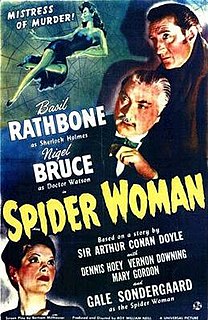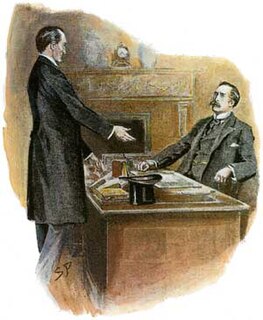"The Adventure of the Deptford Horror" is a Sherlock Holmes story by Adrian Conan Doyle, the youngest son of Sir Arthur Conan Doyle, the Sherlock Holmes creator. The story was published in the 1954 collection The Exploits of Sherlock Holmes . It was first published in Collier's on 18 September 1953, and was illustrated by Robert Fawcett in Collier's. The story was also included in the 1967 anthology Seventeen Steps to 221B. [1]
Holmes and Watson are called to a house in Deptford, due to the concerns of a young woman about her safety. Several of her relatives have died in the past few years of heart attacks. A relative who trains canaries also lives in the house. Holmes is not able to detect anything amiss until he and Watson are en route home, but he suddenly solves the mystery and returns to Deptford to save the life of the young woman from a death by heart failure. [2]
This apocryphal story was inspired by the mention in "The Adventure of Black Peter" of Holmes's "arrest of Wilson, the notorious canary-trainer, which removed a plague-spot from the East-End of London." In this story, Wilson is not arrested, but this discrepancy is explained as an error due to Dr Watson.

A Study in Scarlet is a 1887 detective novel written by Arthur Conan Doyle. The story marks the first appearance of Sherlock Holmes and Dr. Watson, who would become the most famous detective duo in literature. The book's title derives from a speech given by Holmes, a consulting detective, to his friend and chronicler Watson on the nature of his work, in which he describes the story's murder investigation as his "study in scarlet": "There's the scarlet thread of murder running through the colourless skein of life, and our duty is to unravel it, and isolate it, and expose every inch of it."

"The Final Problem" is a short story by Sir Arthur Conan Doyle featuring his detective character Sherlock Holmes. It was first published in The Strand Magazine in the United Kingdom, and McClure's in the United States, under the title "The Adventure of the Final Problem" in December 1893. It appears in book form as part of the collection The Memoirs of Sherlock Holmes.
"The Adventure of the Wax Gamblers" is a Sherlock Holmes short story written in collaboration by Adrian Conan Doyle and John Dickson Carr. The story was published in the 1954 collection The Exploits of Sherlock Holmes. It was first published in Collier's on 20 June 1953, illustrated by Robert Fawcett.
"The Adventure of the Seven Clocks" is a Sherlock Holmes story by Adrian Conan Doyle and John Dickson Carr. The story was published in the 1954 collection The Exploits of Sherlock Holmes. It was first published in Life on 29 December 1952, with illustrations by Adolf Hallman.
"The Adventure of the Red Widow" is a short Sherlock Holmes murder mystery by Adrian Conan Doyle, the youngest son of Sir Arthur Conan Doyle, the Sherlock Holmes creator. The story was published in the 1954 collection The Exploits of Sherlock Holmes. It was first published in Collier's on 2 October 1953, and was illustrated by Robert Fawcett in Collier's.
"The Adventure of the Two Women" is a Sherlock Holmes crime story by Adrian Conan Doyle, the youngest son of Sir Arthur Conan Doyle, the Sherlock Holmes creator. The story was published in the 1954 collection The Exploits of Sherlock Holmes. It was first published in Collier's on 4 September 1953, and was illustrated by Robert Fawcett in Collier's.
"The Adventure of the Highgate Miracle" is a Sherlock Holmes mystery story written in collaboration by Adrian Conan Doyle and John Dickson Carr. The story was published in the 1954 collection, The Exploits of Sherlock Holmes. It was first published in Collier's on 6 June 1953, illustrated by Robert Fawcett.
"The Adventure of the Black Baronet" is a Sherlock Holmes murder mystery written by Adrian Conan Doyle and John Dickson Carr. The story was published in the 1954 collection The Exploits of Sherlock Holmes. It was first published in Collier's on 23 May 1953, illustrated by Robert Fawcett.
"The Adventure of the Sealed Room" is a Sherlock Holmes murder mystery by Adrian Conan Doyle and John Dickson Carr. The story was published in the 1954 collection The Exploits of Sherlock Holmes. It was first published in Collier's on 13 June 1953, and was illustrated by Robert Fawcett in Collier's.
"The Adventure of Foulkes Rath" is a Sherlock Holmes murder mystery by Adrian Conan Doyle, the youngest son of Sir Arthur Conan Doyle, the Sherlock Holmes creator. The story was published in the 1954 collection The Exploits of Sherlock Holmes. It was first published in Collier's on 27 June 1953, and was illustrated by Robert Fawcett in Collier's.
"The Adventure of the Abbas Ruby" is a Sherlock Holmes mystery by Adrian Conan Doyle, the youngest son of Sir Arthur Conan Doyle, the Sherlock Holmes creator. The story was published in the 1954 collection The Exploits of Sherlock Holmes. It was first published in Collier's on 21 August 1953, and was illustrated by Robert Fawcett in Collier's. It was also printed in two issues of the magazine Summertime in 1965, illustrated by Paul Granger.
"The Adventure of the Dark Angels" is a Sherlock Holmes murder mystery by Adrian Conan Doyle, the youngest son of Sir Arthur Conan Doyle, the Sherlock Holmes creator. The story was published in the 1954 collection The Exploits of Sherlock Holmes. It was first published in Collier's on 7 August 1953, and was illustrated by Robert Fawcett in Collier's.

The Canary Trainer: From the Memoirs of John H. Watson is a 1993 Sherlock Holmes pastiche by Nicholas Meyer. Like The Seven Percent Solution and The West End Horror, The Canary Trainer was published as a "lost manuscript" of the late Dr. John H. Watson. In "The Adventure of Black Peter", an original Arthur Conan Doyle Holmes story from 1904, Watson mentions that his companion recently arrested "Wilson, the notorious canary-trainer, which removed a plague-spot from the East-End of London." This Wilson is not related to the eponymous character of Meyer's novel. Meyer's "trainer" is Erik, the principal figure of Gaston Leroux's 1910 novel The Phantom of the Opera. It is from this unchronicled tale that The Notorious Canary Trainers take their name.

The Exploits of Sherlock Holmes is a short story collection of twelve Sherlock Holmes pastiches, first published in 1954. It was written by Adrian Conan Doyle, who was the son of Sir Arthur Conan Doyle, and by John Dickson Carr, who was the authorised biographer of the elder Conan Doyle. The first six stories were written in collaboration by the two writers, while the last six stories were written solely by Adrian Conan Doyle.

"The Adventure of the Second Stain", one of the 56 Sherlock Holmes short stories written by Sir Arthur Conan Doyle, is one of 13 stories in the cycle collected as The Return of Sherlock Holmes (1905) and the only unrecorded case mentioned passively by Watson to be written. It was first published in The Strand Magazine in the United Kingdom in December 1904, and was also published in Collier's in the United States on 28 January 1905. Doyle ranked "The Adventure of the Second Stain" eighth in his list of his twelve favourite Holmes stories.

"The Adventure of the Norwood Builder", one of the 56 short Sherlock Holmes stories written by Sir Arthur Conan Doyle, is the second tale from The Return of Sherlock Holmes. The story was first published in Collier's (US) on 31 October 1903 and in The Strand Magazine (UK) in November 1903.

The Adventure of the Dancing Men is a Sherlock Holmes story written by Sir Arthur Conan Doyle as one of 13 stories in the cycle published as The Return of Sherlock Holmes in 1905. It was first published in The Strand Magazine in the United Kingdom in December 1903, and in Collier's in the United States on 5 December 1903.

"His Last Bow. The War Service of Sherlock Holmes", later titled "His Last Bow: An Epilogue of Sherlock Holmes", is one of 56 short stories about Sherlock Holmes written by Sir Arthur Conan Doyle. It was first published in September 1917 in The Strand Magazine and collected as the last of an anthology of eight stories titled His Last Bow: Some Reminiscences of Sherlock Holmes the following month. The narration is in the third person, instead of the first person narration usually provided by the character of Dr. Watson, and it is a spy story, rather than a detective mystery. Due to its portrayal of British and German spies on the eve of war, its publication during the First World War and its patriotic themes, the story has been interpreted as a propaganda tool intended to boost morale for British readers.

The Spider Woman is a 1943 mystery film starring Basil Rathbone as Sherlock Holmes and Nigel Bruce as Dr. Watson, the seventh of fourteen such films the pair were involved in. As with all of the Universal Studios films in the series, the film is set in then-present day as opposed to the Victorian setting of the original stories. This film incorporates elements from the 1890 novel The Sign of the Four, as well as the short stories "The Final Problem", "The Adventure of the Empty House", "The Adventure of the Speckled Band" and makes explicit reference to "The Adventure of the Devil's Foot".

Traditionally, the canon of Sherlock Holmes consists of the 56 short stories and four novels written by Sir Arthur Conan Doyle. In this context, the term "canon" is an attempt to distinguish between Doyle's original works and subsequent works by other authors using the same characters.